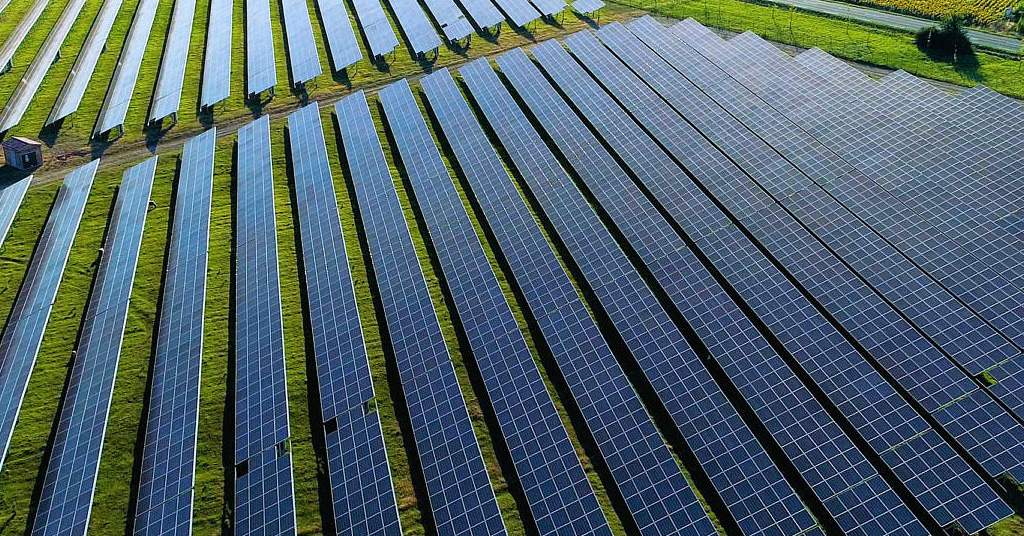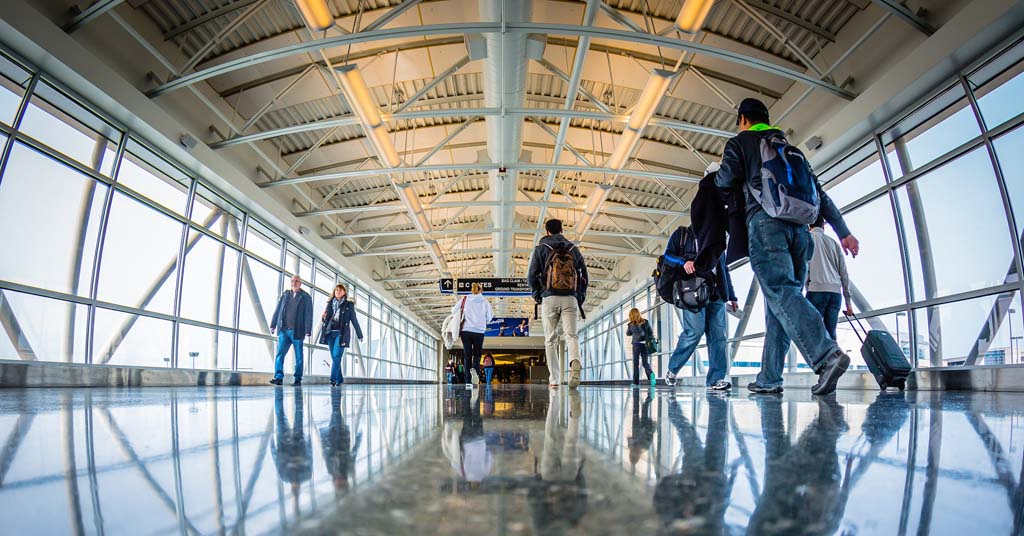Large-scale alternative energy installations aren’t always the win-win for rural counties they’re made out to be
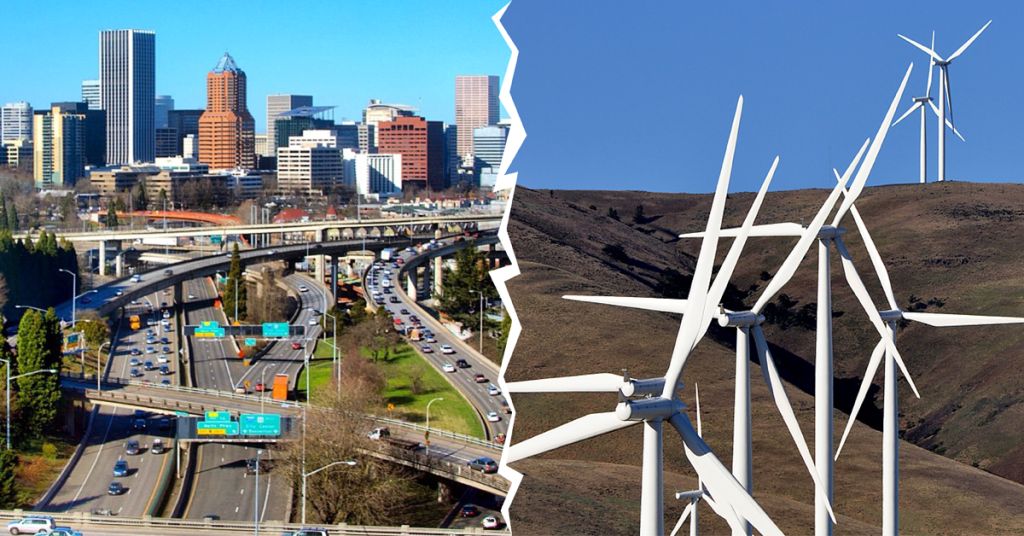
Division of power: Alternative energy installations tend to be located far from the urban centers that increasingly rely on them for energy. Photos: David Evers/CC (Portland), Jurgenhessphotography.com (turbines)
By Steven Hawley. February 10, 2022. For 140 years, Sherman County in north-central Oregon has been fertile wheat country. For the last 20 it’s also been rich wind energy territory.
The two commodities, thought Dave Pinkerton back in the late 1990s, might form the basis of a potentially lucrative strategic partnership.
Pinkerton Ranch has been growing wheat in the loamy soil and semi-arid rolling hills of western Sherman County, near the town of Moro, since Pinkerton’s great-grandfather seeded ground here in 1889. In the living room of the house that patriarch of the family built in 1890, his great-grandson watches a farm economics report blaring from a 50-inch, flat-screen TV.
Pinkerton’s 65-year-old face is all farmer—the lines around the eyes and mouth trace a career and family history of great pride, wry Irish humor and satisfaction in the work.
But there’s a tension in those lines that also conveys a farmer’s constant companion. He’s worried.
“I’m retired. So I just get to do the fun stuff. But now my son-in-law pays the bills,” says Pinkerton. “And right now the costs are enormous.”
He describes the scarcity, and subsequent skyrocketing price, of inputs: seed, chemicals, software that modern farm equipment utilizes to maximize efficiency.
“And now they say if the Russians get into Ukraine, we’ll have $200-a-barrel petroleum. That means $8-a-gallon diesel,” he says. “There’s not much good news. Kinda makes me want to turn it to the cartoon channel.”
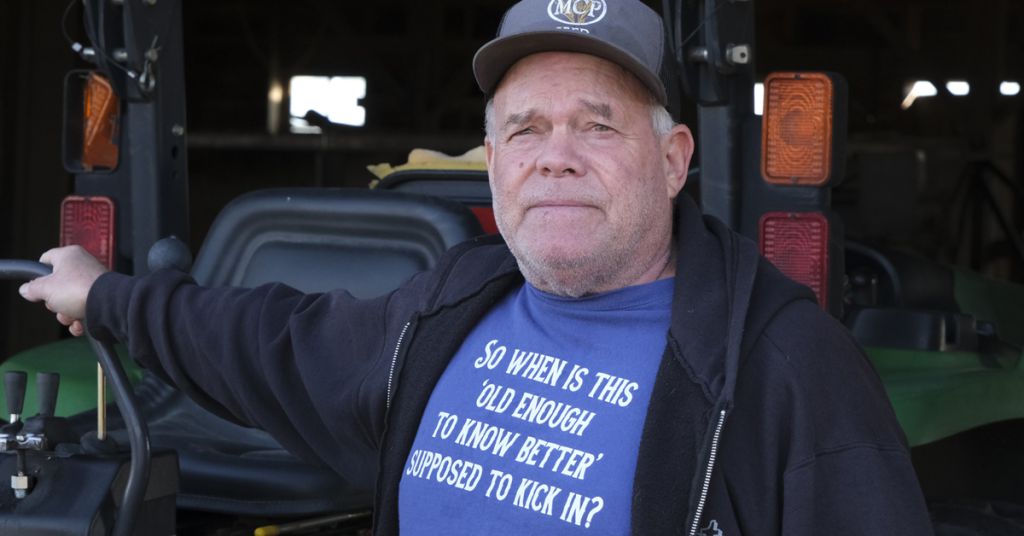
Wheat and wind: Oregon farmer Dave Pinkerton has leased a sizable part his land to wind energy concerns. Photo: Jurgenhessphotography.com
Twenty-five years ago, the vagaries of farm life were somewhat ameliorated when the wind power industry came knocking. Leasing land to energy companies hopping early onto the push to embrace renewable power was a way to insulate against the economic risk factors in farming.
“It’s some money, not a lot,” says Pinkerton. “It’ll help me retire with some beer money, and it will be there for the kids when I’m gone.”
But it’s not without its complications.
Pinkerton points out that it’s landowners, not strictly farmers, who benefit from these leases.
“I was in a position to negotiate, because we own some [about half of the 5,000 acres Pinkerton Ranch cultivates] of our own ground,” he says. “But the farmer who’s leasing ground doesn’t benefit. And since he needs to maintain a good relationship with his landlord, he’s less likely to complain. So if that guy has a couple off years, he’s not farming anymore. And that’s not good, because there’s fewer and fewer of us.”
The advent of wind power has arguably been good financially for Sherman County. A windfall of millions of dollars has allowed the county to improve its schools, build a new courthouse and better maintain its roads. Each of the county’s 1,800 residents over 18 gets a check, courtesy of wind power revenue, for $590 each year.
Yet Pinkerton worries about factors beyond the bottom line.
“When they sell this as a green energy project, he says, “there’s nothing green about it.”
Growing inequality
Over the coming year, Columbia Insight will be investigating the growing footprint of renewable energy projects in rural Oregon and around the Columbia River Basin.
To many urban-dwellers in the region, the prospect of a big wind or solar project means progress toward the urgent goal of weaning civilization off fossil fuel.
But to those with roots in farm or timber country, these projects sometimes represent nothing more than a new wrinkle in an old pattern: resource extraction by monied interests that call the shots from an office at least several zip codes away, perhaps a few jobs, and too often, lasting damage to local water, soil, fish, wildlife and the once-pristine view.
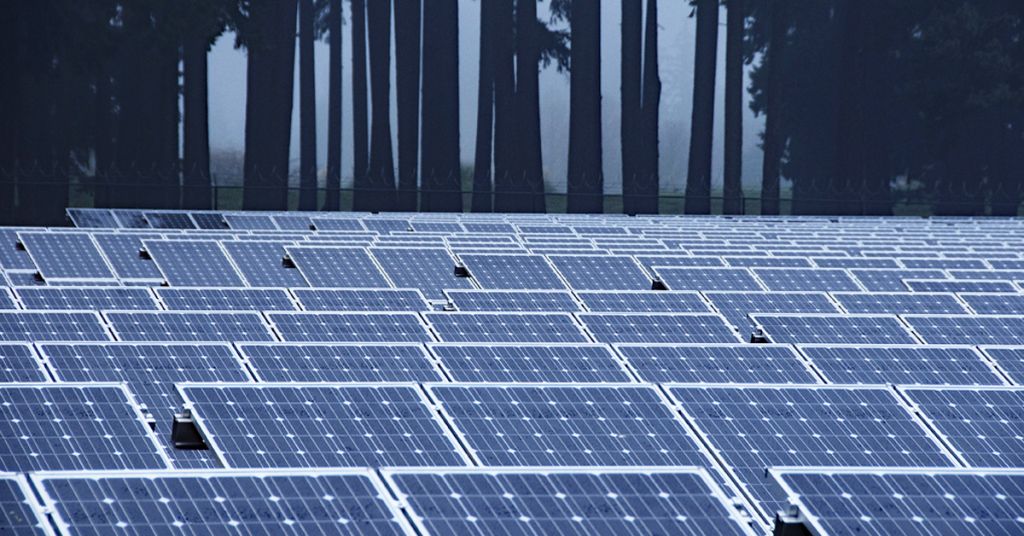
Bright or blight? The Baldock Solar Station is 1.75 megawatt solar array south of Portland. Photo: Oregon Department of Transportation
Don Albrecht is a rural sociologist and director of The Rural Development Center housed at Utah State University. He describes a crisis in rural western America long in the making that has metastatized over the past five years.
He points to grim statistics: the average male worker [in rural communities] makes less than they did in 1973 in constant dollars. In non-metropolitan counties, the poverty rate has actually increased since the Great Recession of 2007 to 2009.
Two-thirds of jobs in logging and wood products manufacturing are gone.
The trend translates in Oregon to an urban-rural income inequality. According to U.S. Census data, the average Clackamas County (which is predominately suburban Portland) household income is $62,000. In Wheeler County, south of Sherman County and out of the wind-power boom, it’s $33,000.
MORE: What’s wrong with solar power? More than you know
The cause of much of this decline, says Albrecht, is automation.
“I did some work in a timber town in Idaho a few years ago,” he says. “One of the county commissioners told me that when he was a kid, his county had nine saw mills, and now they had just one. And if I could bring back the eight they’d lost, the county’s problems would be solved.
“But those mills are not coming back. For starters, it’s possible that one remaining saw mill on its own can produce what the other eight did combined. So the jobs are going away, but the jobs remaining don’t pay much. Anger and frustration have increased.”
Lots of energy, lots of land
Economically stagnant, some rural communities seem particularly vulnerable to the overtures of a big company pitching an energy project that might help save the temperate version of the planet.
Can these companies help break both the habits of fossil fuel dependence and rural resource exploitation?
Dave Pinkerton is skeptical.
“When they put up one of these towers, they use more gas and diesel in one day than we use on our farm in an entire year,” he says.
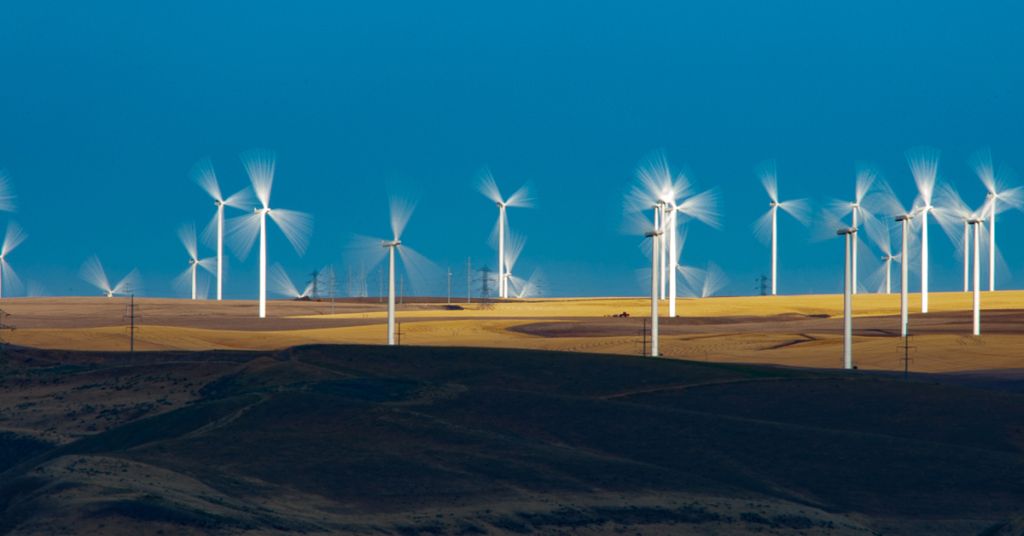
You can’t eat the view: But you can grow crops on some of the land occupied by wind towers in Oregon’s Sherman County. Photo: Jurgenhessphotography.com
The kind of power that only an internal combustion engine can produce is needed because the wind towers are gargantuan, 600 feet tall when one of the three turbine blades points skyward parallel to the tower base.
“The crane they bring in here weighs 2 million pounds,” says Pinkerton.
He’s become concerned about the future of the soil that has supplied his family with a decent living for more than a century.
“When we first signed a deal to put towers on our ground, we were told a half-an-acre footprint for each of them,” he says. “We signed up for four towers and figured we’d lose two acres. Those were 1.5 megawatt towers. But these new ones are bigger, 4.3 megawatts. And the last one they put in they took somewhere between seven and 12 acres.”
Acres of mud
Pinkerton pulls on a pair of boots, and we hop in his truck for a tour.
After the thick frost on the windshield clears, we look east across the miles-long view, over a succession of brown, eyebrow-shaped hilltops studded with gray wheat stubble, a hint of green here and there where next year’s crop has sprouted.
There are wind towers as far as you can see.
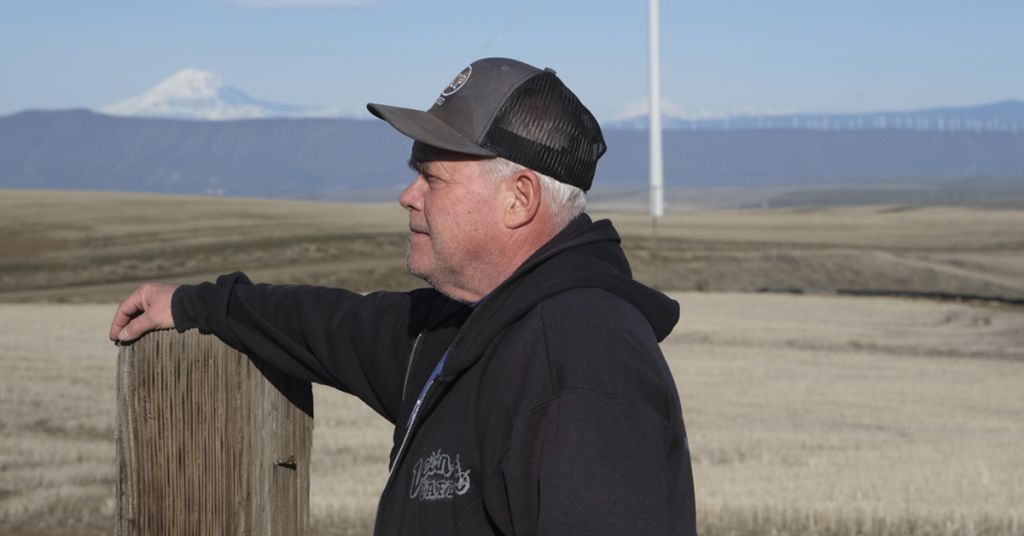
Outside influence: Dave Pinkerton on his Oregon farm within view of turbine towers and Mt. Adams in Washington. Photo: Jurgenhessphotography.com
He points out several places where contractors for Avengrid and Brookfield, two foreign companies invested in local wind farms, re-routed access roads in a way that will make it more difficult to move farm equipment around them.
He stops at the single mammoth tower. Installed last summer, it inspired him to start complaining loudly.
In September 2021, Pinkerton and 10 other farmers sent a letter to Oregon’s Energy Facility Siting Council alleging that developer Avangrid Renewables had failed to comply with requirements for building the Golden Hills Wind Project, in Sherman County, a project that would drop 51 turbines on 29,500 acres.
“Look at this,” he says. “You could fit four or five football fields in this mess.”
The wind whips up, rippling the surface of a puddle on the edge of at least five acres of barren mud.
MORE: Rural solar project in Oregon faces local opposition, wildlife concerns
“I told these guys, if you see a pool, you have a problem. You did something wrong,” says Pinkerton. “That water needs to drain back in the ground. We’ve practiced soil conservation for at least 50 years here, up to and including a lot of our ground now being no-till.
“We don’t lose soil anymore. We might lose some water, but it comes off clean. They say they’ll put all this back, and it’ll be good as it was before. But I can tell you, soil compaction is forever.”
Shouting into the wind
We grind back to Pinkerton’s place. He shows me his shop, part of which he’s converting into an improvised sports bar, complete with neon signs and a pool table, a retirement project.
There’s a small “Trump 2020” flag among lots of flags hanging from the rafters.
“I’m a conservative, but I have liberal friends, and we disagree, but we get along, which is pretty important in this world,” he says.
He tells me about a meeting he had recently with several wind industry representatives in his shop/bar, after he began voicing his concerns.
“There were six of us in here,” says Pinkerton, “and one of the company guys says ‘nice work, you have raised the ire of every anti-wind group around.’ And I said, ‘Wait a minute, you didn’t do things the way we agreed you’d do them, and I’m practicing my First Amendment rights because of it.’”
Appreciate this story? Consider donating to Columbia Insight.
What Pinkerton wants is for boots-on-the-ground farmers to be involved in the layout and construction of any new towers or existing tower upgrades. To preserve valuable ground, he says, you have to have eyes on it that know what they’re looking at.
It’s the kind of familiarity that comes with living your whole life in the house and on the farm your great-grandfather built.
The end of the story of the summit meeting in the barn, says Pinkerton, went like this: upon closer examination of the paperwork, it turned out the roads were changed to accommodate tower construction without consulting the right people—the ones on whose property the towers and roads were built.
“One of them asked if I wanted them to put the roads where we’d originally had them planned,” says Pinkerton. “Well you can’t just put a road back once it’s built. I said ‘it’s very kind of you to offer, but it’s too late. I wish you’d have asked me before you did it.’”
The Fred W. Fields Fund of Oregon Community Foundation supported this story.






